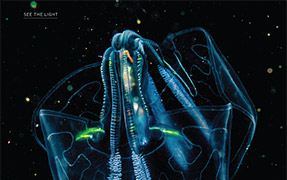Closing the gap

Metamaterial consisting of copper split ring resonators on thin fiberglass circuit board material acts asa negative refractive index material for the microwave region. (UCSD)
Optical integrated circuits, high-efficiency solid-state lighting, and materials that actually have a negative index of refraction are all possible thanks to advances in photonic bandgap crystals. "These systems essentially give us a new mechanism of controlling light," says professor John Joannopoulos of the Massachusetts Institute of Technology (MIT; Cambridge, MA). At the recent American Association for the Advancement of Science meeting (AAAS; 1419 February; Boston, MA), Joannopoulos brought together a number of photonic bandgap researchers in a nanophotonics session "to show all the neat stuff that can be done," he says.
Photonic bandgap crystals use a periodic structure of components with high and low indexes of refraction to create a range of frequencies at which light is not allowed to propagate through the material (see oemagazine, October 2001, page 28). If the photonic bandgap structure within the material is then broken, the irregularity creates microcavities and waveguides through which light can travel. The setup allows engineers to manipulate light at scales on the order of half a wavelength, which lets them build highly dense optical devices. Researchers in the area are enthusiastic about the possibilities. "I believe that the optical world will slowly creep its way into the electronics world by replacing certain functionalities on a chip," says Axel Scherer of the California Institute of Technology (Pasadena, CA).
For instance, engineers could build a series of closely spaced vertical-cavity surface-emitting lasers (VCSELs) on a chip and vary their lasing frequency based on the geometry of the bandgap structures. One laser could pump the laser next to it, or light at different frequencies could be channeled in different directions, leading to tunable chips. Light-emitting diodes (LEDs), which typically dissipate 80% of the light they produce, could be built with a periodic structure that would force out more light, making them much more efficient. In the AAAS session, Shanhui Fan of Stanford University (Stanford, CA) described his design of an optical add/drop filter that can be turned on and off by introducing partially reflecting elements into the waveguide. "As you switch the resonance frequency of the cavity a little bit, you can change the cavity from a complete transmission to a complete reflection," he said.
Perhaps the most unusual presentation came from Sheldon Schultz of the University of California (San Diego, CA). He has built what he calls a "metamaterial," with a negative index of refraction. The material takes advantage of a special solution to Maxwell's equation in which both the electric permittivity and the magnetic permeability are negative. Schultz built his material out of ordinary copper rings and wires, arranged in a periodic configuration that he describes as looking like the cardboard dividers that come in a case of wine. "There's no violation of physics. There's no violation of Maxwell's equations. It's just a particular solution that the world had neglected for 150 years," says Schultz, who has so far only demonstrated the effect at microwave wavelengths.
Joannopoulos and his group at MIT have theoretically demonstrated, though not yet published, the fact that photonic bandgap crystals would allow the creation of materials with a negative refractive index at visible wavelengths. That could lead to lenses with parallel sides and no optical axis able to focus a point image. Such characteristics, says Joannopoulos, could be important in focusing and controlling light at very small scales, where it is near impossible to make a convex lens. It will probably be at least five years before someone can build such a material, however, he adds.



